IDEX Online Research: Jewelry Supplier Price Up, Retail Prices Down in August
October 01, 09
Inflation at the jewelry supplier level remained moderate in August, while retail prices of jewelry experienced modest deflation. At the supplier level, inflation has bounced around over the past few months, but it is still very low, when compared to a year ago. Higher precious metals prices are primarily driving the Jewelry Producer Price Index (JPPI).
At the retail level, prices experienced modest deflation. Jewelry and watches were below last year’s levels by just under 1 percent, continuing a deflationary trend which has characterized this level in the distribution channel since August 2008, when inflation peaked at a rampant 9 percent annualized rate.
Suppliers Push Jewelry Prices Up; Retailers’ Prices Slip
Here’s the summary of inflation at the jewelry retail and supplier level for the month of August 2009, as expressed as a percentage change year-over-year (2009 versus 2008) in the U.S. market:
- Jewelry Producer Price Index +2.8
- Platinum & Gold Used in Jewelry +1.9 percent
- Other Precious Metals Used in Jewelry 2.8 percent*
- Watches & clocks +1.2 percent*
- Findings, Materials & Lapidary Work +10.0 percent (since December 2008)*
- Jewelry & Watch Consumer Price Index (0.9 percent)
- Jewelry CPI (0.8 percent)
- Watch CPI (1.9 percent)
* New JPPI measures
Now that gold and other precious metals prices have risen significantly, the big question is this: How long before those new prices show up at retail? Jewelry prices at the producer level rose in August, ostensibly driven primarily by precious metals price increases. If producer prices continue to rise, it could be bad news as the jewelry industry enters the all-important holiday selling season: retail jewelers will be forced to raise prices or suffer from margin deterioration.
The graph below compares the Jewelry Producer Price Index (red bar) with the Jewelry Consumer Price Index (green bar).
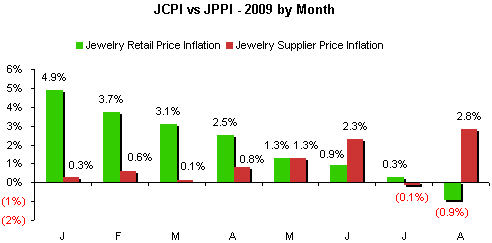 Source: BLS |
 |
The August JPPI was well below the average of the Jewelry Producer Price Index for 2008, which averaged +6.3 percent for the full year. However, the +2.8 percent inflation rate in August is above the annual inflation rate – which averaged about +0.7 percent – that characterized the jewelry producer industry in 2000 through 2002, also a recessionary period. August’s inflation rate was also above the long term Jewelry Producer Price Index increase of about +1.4-1.5 percent annually.
The following graph summarizes the monthly Jewelry Producer Price Index for inflation since mid-2007. The percentage figures are based on year-to-year comparisons of the BLS Jewelry Producer Price Index (August 2009 versus August 2008).
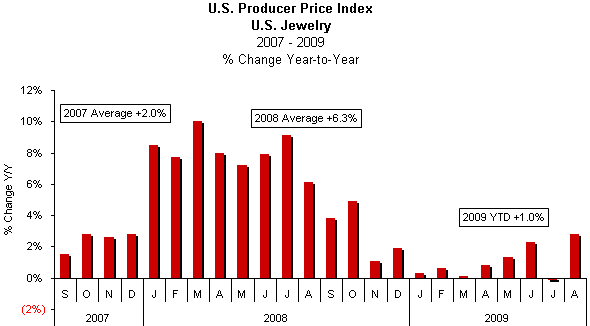 Source: BLS |
Inflation By Commodity Up in August versus July
After showing only very modest increases earlier this year, prices for both precious metal jewelry and gemstone jewelry rose in the second quarter, fell back in July, and bounced upward in August. The graph below compares the JPPI (red bars) to inflation for precious metals (gold bars); gold had been the primary driver of precious metals inflation in 2007 and most of 2008. In January, gold prices pulled back modestly, but rose recently. In our opinion, $1,000 gold has been priced into goods produced by jewelry manufacturers. If gold goes higher, as some analysts suggest, that will put further pressure on jewelry suppliers to raise prices.
As the graph below illustrates, prices for precious metals used in jewelry at the supplier (producer) level showed notable inflation, retreated in July, and returned in August.
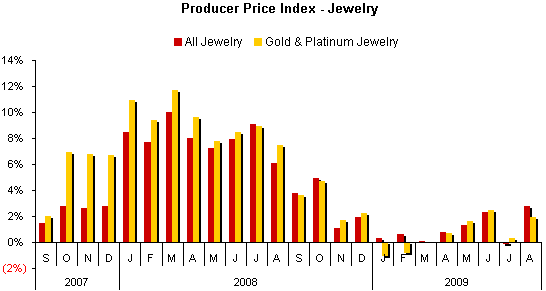 Source: BLS |
Revisions in watch price inflation at the producer level were made in August. We had wondered how watch price inflation could be so low earlier this year, despite some shortages at the manufacturing level in the channel of distribution. It is clear that earlier numbers were apparently incorrect.
Like all producer prices, watch prices heated up in 2008, and remained high through early spring. In June, watch prices inflation nearly evaporated, and continues to fall.
The following graph summarizes producer price inflation and deflation for watches in the U.S. market.
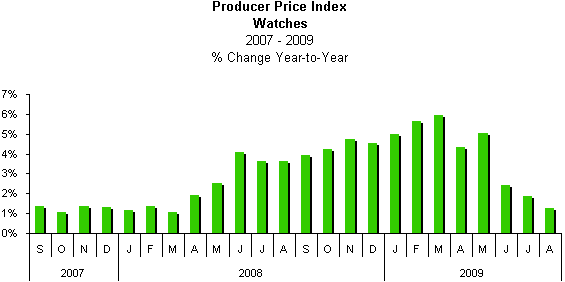 Source: BLS |
 |
For the full year 2008, retail price inflation for jewelry in the U.S. market ran at an annual rate of +6.9 percent. Now, however, it is clear that jewelry price inflation is moderating, and it will likely remain lower than 2008 in the coming months, especially since we have reached the anniversary of last year’s price increases that jewelers implemented in the second quarter of 2008. We had originally predicted that retail jewelry price inflation might be flat in 2009; this is probably unlikely, though the year-to-date average continues to fall each month. For the eight months year-to-date, retail price inflation for jewelry is +2.0 percent. If we have a few more months of deflationary pricing, jewelry prices could be flat for the year.
The graph below summarizes the percentage change in retail prices of jewelry and watches by month on a year-to-year basis since the beginning of 2008. The percentage change is based on a comparison to the same month a year ago (August 2009 versus August 2008).
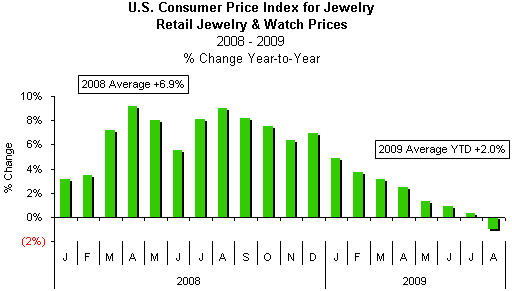 Source: BLS |
Watch Prices Show Deflation in August
After bouncing around for several months, it became clear in the second quarter that watch price inflation at the retail level was moderating. Early in 2008, the components of jewelry and watch price inflation at the retail level reflected a disparity in price increases. Jewelry retail prices were up consistently during the first half of 2008, but watch retail prices showed virtually no price inflation. Earlier this year, watch price inflation steadily increased at the retail level. In April, watch price inflation slowed dramatically. In May, retail prices of watches inched higher than in April, but the inflation rate was still below earlier months this year. In June, watch price inflation diminished significantly. In July and August, watch prices dipped – experienced deflation – in the U.S. market. We expect watch price inflation to track more closely to retail jewelry price inflation over the near term.
The graph below illustrates the JCPI consisting of both jewelry and watch prices (green bars), jewelry prices only (red bars), and watch prices (yellow bars).
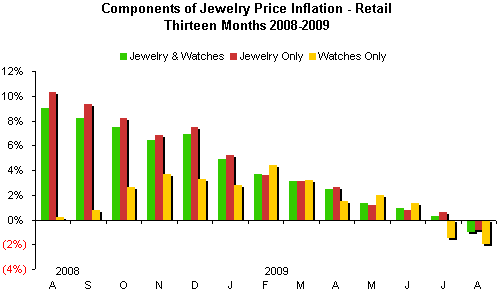 Source: BLS |
Outlook: Modest Jewelry Price Inflation in 2009
After rising by nearly 7 percent in 2008, we continue to forecast much more modest jewelry and watch price inflation during 2009. The wild card, of course, is the price of commodities, including gold, silver, and platinum. If investors continue to buy these commodities as hedges against inflation – as historical economic recovery models suggest – it will put upward cost pressure on jewelry suppliers, who will try to pass those price increases along to retailers.
Our current prediction calls for 2009 jewelry price inflation to be in the low single digit positive level. The U.S. economy – which accounts for roughly half of all jewelry demand worldwide (by value) – is showing signs that the recession has bottomed. Thus, if consumer demand recovers, we should not experience price deflation; instead, we could experience modest price inflation.